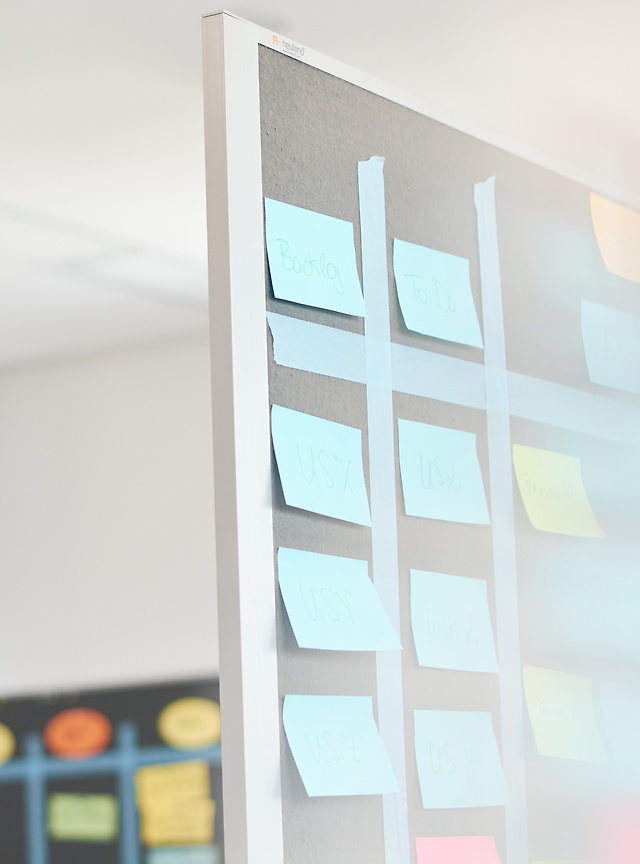10. May 2024 By Viktoria Düngfelder
Overview of large group moderation - effective methods for successful events
Interactive formats are a proven alternative to traditional conferences and symposia. The latter often fail due to a lack of dialogue between participants. The ironic saying "The best thing about the conference was the breaks" conversely explains how important networking, information exchange and joint learning are today.
When companies are faced with change, questions often arise such as: "How can we inform employees about our plans and encourage them to support them? In such situations, it is important to find a way to enter into an open dialogue with employees.
Large group facilitation is a socio-psychological method for communicating effectively, gathering ideas and making decisions in large planning and decision-making groups. This form of facilitation is often used at conferences, workshops or other events with many participants (up to 2000). In this blog post, I would like to introduce two common methods of large group facilitation and explain how they can be used successfully.
Method 1: World Café
Procedure
The World Café encourages informal discussions that can lead to new ideas. The participants sit at coffee house tables with space for four to six people. The informal atmosphere is supported by typical café elements: a "menu" (questions and instructions on how to proceed), a "tablecloth" (paper for recording ideas), "cutlery" (consisting of pens and markers) as well as snacks and drinks.
During the event, a moderator first explains the procedure. The participants are then asked to sit down at small tables in the room, which are set up like coffee tables. There they are asked to discuss a given topic. The key ideas are recorded on the paper tablecloths. After about 20 minutes, the first round of discussion is over. The participants change tables and form new groups, with one host remaining behind. The host reports to the new group at the table on the progress of the previous discussion and names the most important results. The new group then discusses the same topic for around 20 minutes. New groups are formed again for the next and often final round of discussions, in which a further question is often discussed. After the last round of discussions, the results are summarised in plenary.
Added value
Repeated questioning at different café tables allows participants to benefit from a variety of sources of knowledge and gain new insights. The diversity of participants makes it possible to adopt different perspectives and develop a more comprehensive understanding of issues and challenges. The method promotes structured clarification processes and quickly leads to focussed and usable results.
Possible applications
World Cafés promote dialogue between large groups of people and create a sense of togetherness. They are primarily used as an introduction to larger events.
The organisation of a World Café is suitable for
- get large groups talking to each other
- develop strategies and action plans
- generate and structure new ideas
- optimise existing processes or procedures
Method 2: Future Search / Future Conference
Procedure
When inviting people to the future conference, care is taken to ensure that all relevant stakeholders in the "overall system" are invited. This includes not only the interest groups directly affected, but also those who are confronted with the consequences of the decisions made. Each of these groups brings its own perspective on the problem and can contribute valuable expertise to finding solutions.
A future conference is divided into six phases:
Phase 1: Reflection on the past
In this phase, the history of the organisation or institution is examined. Highlights, milestones and other important developments are summarised in order to obtain a comprehensive picture of the system's past. Both positive and problematic developments are highlighted and consequences for the future are derived. The aim of this phase is to create a common basis and a sense of community in order to facilitate constructive dialogue.
Phase 2: Evaluation of the present - outside
In this phase, facts and perceptions of developments and trends that have an impact on the organisation or institution are collected. The most important trends are identified and analysed in terms of their impact.
Phase 3: Evaluation of the present - internal
In this phase, the inner workings of the system are analysed. It examines what those involved are proud of and what they regret. The perceptions of all those involved are collected and interpreted. This phase promotes awareness of shared values and often stimulates an intensive exchange of information. At the end, it becomes clear which aspects the participants want to take with them into the future and which they want to leave behind.
Phase 4: Developing a vision for the future
Using creative methods, the shared future is brought to life and made tangible and then presented. Common goals, wishes and hopes are visualised and core wishes are identified.
Phase 5: Finding consensus
The commonalities of the different visions of the future are worked out and brought together to form a common vision of the future.
Phase 6: Planning specific measures
This is followed by securing the results and transferring them into practice. To this end, project groups are formed to develop measures and define responsibilities so that implementation can begin once the conference is over.
The individual steps systematically build on each other. Step by step, the participants gain insights that ultimately result in the action plan or joint strategy.
Added value
Future conferences are among the most effective key instruments for holistic and effective management. They have a profound effect on companies and organisations. The "whole system" approach makes it possible to recognise all challenges immediately when solving problems and to solve them in the same process. Even complex problems with many participants can be solved in a short time. However, the amount of preparation required is considerable, as the conference is an essential part of an organisational development process that needs to be carefully planned. As a rule, at least two and a half days should be planned for the organisation of a future conference alone.
Possible applications
This form of participation is particularly suitable for organisations and groups from business and society that are viewed as a coherent system and are interdependent (e.g. an organisation and its periphery) or are at least closely linked, whereby a common consensus for the future is fundamental. The method takes into account the big picture and all facets of the issue, which makes it ideal for developing solutions to relevant problems. It can also be used to find consensus in conflict groups with different interests.
Conclusion
The various concepts of large group facilitation are approaches for organising communication processes. In practice, they are adapted depending on the size of the group, the initial situation and the objectives. This is why mixed forms are often used in day-to-day operations. However, this is only a small selection of the possibilities.
Managing large groups is a challenge. There can be various reasons why it sometimes doesn't work. One popular and widely used method is the World Café. It is important that the moderators do not tire of experimenting. Less common moderation methods such as RTSC conferences, fishbowl discussions or the Appreciative Inquiry method can also provide good experiences.
In order to achieve the desired goals, it is important - as trivial as it may sound - to know which goals you want to achieve in the first place. No matter how well trained and experienced a moderator or facilitator is, the more people are involved in a discussion, the more difficult it will be to achieve results. During preparation, it is therefore important to work out which specific topic is to be discussed. Care should be taken to ensure that the questions build on each other, but are still clearly defined and generate as creative an exchange as possible. Last but not least, it is also important for the moderator or facilitator to know which participants have a more conventional point of view and which are contributing new insights. It is therefore also a crucial task to encourage reserved, quiet participants to contribute and to prevent dominant, loud participants from taking over the discussion.
Would you like to find out more about exciting topics from the world of adesso? Then take a look at our previous blog posts.

